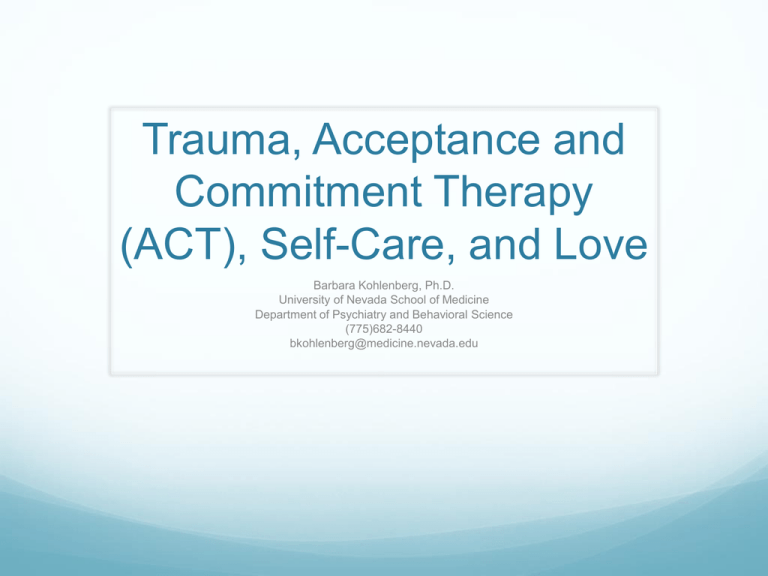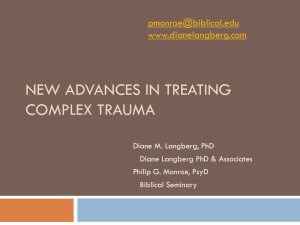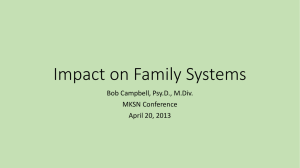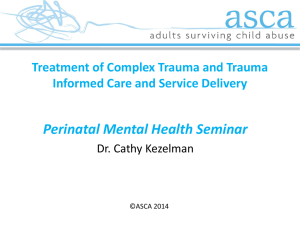Trauma, Acceptance and Commitment Therapy
advertisement

Trauma, Acceptance and Commitment Therapy (ACT), Self-Care, and Love Barbara Kohlenberg, Ph.D. University of Nevada School of Medicine Department of Psychiatry and Behavioral Science (775)682-8440 bkohlenberg@medicine.nevada.edu My Guiding Star “For one human being to love another: that is perhaps the most difficult of our tasks; the ultimate, the last test and proof, the work for which all other work is but preparation.” - Rainer Maria Rilke What we will do… What is trauma? What are personal responses to trauma? What is ACT? How can ACT help you develop a compassionate and loving self care plan in response to trauma? How trauma can lead to stress and burnout, and how ACT can help restore vitality. What is Trauma? (OED) a deeply distressing or disturbing experience: a personal trauma like the death of a child emotional shock following a stressful event or a physical injury, which may lead to longterm neurosis: the event is relived with all the accompanying trauma Medicine physical injury: rupture of the diaphragm caused by blunt trauma Origin: late 17th century: from Greek, literally 'wound' Who has been traumatized? It is epidemic. Over 50% of the U.S. population experience traumatic events in their lifetimes; the rate of people exposed to trauma who then develop Post-Traumatic Stress Disorder (PTSD) is 5% for men and 10.4% for women (Kessler, Sonnega, Bromet, Hughes, & Nelson, 1995). Trauma can be Civilian: Accidents, personal relationships, violence. Extraordinary: War, natural disasters, terrorism. Trauma can be near, far, intimate, catastrophic Trauma right here… Nurses Death, dying, tragedy, violence, cruelty, pain and anguish. Moral distress The feeing that a nurse knows the right thing to do but is unable to do so because of institutional constraints. Tend and Befriend in the ICU: Critical Care Nurse, 2012;32[3]:25-34 Your work… 20-30% of adult critical care nurses surveyed had PTSD symptoms related to their work. (3.5 prevalence, 6.8% lifetime rate) Stressors most commonly linked to PTSD symptoms were not end of life issues or witnessing violent trauma, but were related to work conditions such as feeling overextended, fear of adverse events due to their care, poor team interactions, direct threats such as combative patients and verbal abuse from family members. Symptoms of PTSD Among Pediatric Acute Care Nurses, Czaja et al, (Journal of Pediatric Nursing (2012), 27, 357-364) How do we, in this room, respond to the trauma of others? How do we, in this room, respond to our own trauma? A thought… “The only whole heart is one that has been broken.” (Many sources…Kabbalah, Catholic website) A personal description of trauma (Thanks to Robin Walser, Ph.D.) “In an area near Fallujah the bombing has been so extensive that it has changed the soil. It’s estimated that some 8 bombs were dropped per 1000 square yards. There is no other dirt like it on earth. It has been bombed to the point where nothing lives in the soil no insects, no bacteria, nothing. I am that dirt.” -Client “I am that dirt” “I need help” “I need to be healed” Healing from Traumatic Experiences The word “heal” comes from a word meaning “whole”. The patient comes to the us to be made whole again. Patients believe that healing involves forgetting, getting away from, in some way controlling past traumas, cutting them out of their lives. Who wouldn’t want this? Yet at what cost? What goes when the feeling goes? What to do? How to help this person? How to help ourselves when helping this person? Cure through… Regaining confidence? Increasing self esteem? No longer experiencing the memories? No longer experiencing anxiety of sadness? At a fundamental level no longer being broken by the experience? And most have given up important parts of their lives in efforts to be made whole. Acceptance and Commitment Therapy: Another Way Many therapies, and medications, are focused on helping people get rid of their painful thoughts and feelings. ACT is committed to helping people change their relationship with their thoughts and feelings, in the service of living a life connected to cherished values. One’s thoughts and feelings may never change. ACT is a robust, internationally acclaimed, empirically based treatment. (http://contextualscience.org) Acceptance and Commitment Therapy (ACT) What is it? One of the new wave behavior therapies. Based on behavioral science, particularly the study of language. Developed by Steve Hayes, Ph.D., Professor in the Department of Psychology at UNR. And many others. Departs from cognitive therapy in significant ways. Many therapies are focused on helping reduce suffering and symptoms. ACT is focused on helping each of us develop new relationships with our suffering and our symptoms, so that we can move forward toward cherished, heartfelt dreams and values, without having to get rid of any part of who we are. From an ACT perspective Suffering is pervasive and can be unexpected and terrible pains will visit us all. It is what we do with these pains that makes the difference. A principle: “If you are not willing to have it, you’ve got it” The problem of control. ACT • • • • A compassionate relationship with the self Not based on changing or being broken. Start where you are: the present moment. Encourages contact with previously avoided private events as you experience them in the present moment. • Sadness is not “unbearable” or “shameful.” It’s an emotion that comes and goes. Acceptance and the Field of Trauma Acceptance suggests: The wholeness is already there… We are fundamentally whole, with our histories, our painful events, our joys, our sorrows, our loves. Examples Unwanted thoughts and feelings, memories/values Grief/family Abuse/Intimacy Medical error/valued caregiving Acceptance and Values Why accept? It must be in the service of something powerful, not just the alleviation of pain. Tombstone Metaphor Funeral Metaphor Bus metaphor Coin metaphor The notion of self acceptance and compassion being central to one’s own peace as well as to being able to give to others is not new. Father Greg Boyle on the Calling of Delight: Gangs, Service, Kinship. (Krista Tippett, Onbeing.org, February 28, 2013) “You know…I guess you could say that my mom and me, we didn’t get along so good. I guess I was six when she looked at me and she said “Why don’t you just go kill yourself? You’re such a burden to me.” “You know…I guess I was nine when my mom drove me down to the deepest part of Baja California, and she walked me up to an orphanage and she said “I found this kid.” “I was there 90 days until my grandmother could get out of her where she had dumped me and she came and rescued me.” “My mom beat me every single day. In fact, I had to wear three t-shirts to school every day.” And he kind of loses the battle with his own tears a bit and he says: “I wore three T-shirts well into my adult years, because I was ashamed of my wounds. I didn’t want anybody to see them. But now my wounds are my friends. I welcome my wounds. I run my fingers over my wounds.” “How can I help the wounded if I don’t welcome my own wounds?” And awe came upon everyone because we’re inclined to kind of judge this kid, who, you know, went to prison, is tatooed and is a gang member and homeless and a heroine addict and the list goes on. But he was never seeking anything when he ended up in those places. He was always fleeing the story I just told you. ACT sensibilities Our histories are unchangeable (how can I stop remembering my trauma, can I undo my history) (I need to not feel what I feel when I have memories…I need to fix my insides before I live my life. Once PTSD goes away…once I am over my grief…)_ Or…can we take our history with us, compassionately, kindly, lovingly. As we live a valued life? ACT and your self care What is on your tombstone? What do you want said at your retirement party? What are your traumas, your grief, your pain, that you have been wanting to get rid of? Can you take them with compassionately, on your journey? The Task for Our Patients/ and Ourselves To feel what there is to feel about the sorrow and tragedy that is in life, and to feel awake and alive to all that is joyful in life. Thank you for your work Life will break you. Nobody can protect you from that, and living alone won’t either, for solitude will also break you with its yearning. You have to love. You have to feel. It is the reason you are here on earth. You are here to risk your heart. You are here to be swallowed up. And when it happens that you are broken, or betrayed, or left, or hurt, or death brushes near, let yourself sit by an apple tree and listen to the apples falling all around you in heaps, wasting their sweetness. Tell yourself that you tasted as many as you could. Louise Erdrich The Painted Drum Questions?











